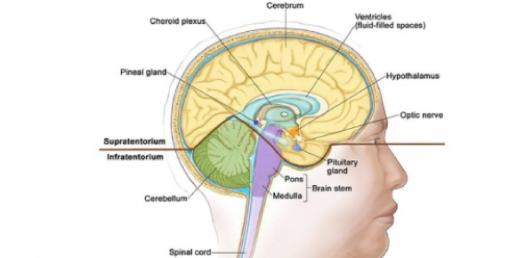Pituitary gland is controlled by
The anterior pituitary arises embryologically as an:
Hypothalamus connected to pituitary gland via
Hypersecretion of growth hormoneWhich condition is seen when there is...
The pituitary gland lies in the
What is Grave's disease?
What are the parts of the anterior pituitary?
Which are the hormones that are produced from amino acids?
The hormones of the posterior pituitary are synthesized as a larger...
Besides tumours, hyperthyroidism can also be caused by?
The growth effect of the growth hormone is mediated by insulin-like...
There are 2 different type of chromophils (of the pars anterior), the...
Which receptor does ADH bind to to increase the water channels in the...
Hyposecretion of Growth hormone.Which type of condition corresponds to...
Which approach does the surgeon take for a pituitary gland surgery?
Which nuclei of the hypothalamus stimulates the anterior pituitary?
What is Sheehan's syndrome?
How do you calculate the BMI?
There are 2 types of nuclei in the posterior pituitary. The...
Which are the hormones produced from lipid? (cholesterol/steroids)
This is a surgical measure taken to treat a pituitary tumour because...
Which are the secretory cells of the pars anterior?
All glycoprotein hormones (TSH, LH, FSH) consist of alpha & beta
...
How is a microadenoma classified?
Why does steroid hormones (sex hormone & cortisol) & thyroid...
Which of these is the BMI range by which one is considered overweight?
What happens where there is deficiency in vasopressin?
There are 2 types of diabetes insipidus: 2 types: 1) Cranial DI...
In gigantism & acromegaly, a patient will appear with prognatism...
What is this child suffering from?
What is Wermer's syndrome also known as?
Excessive growth hormone secretion can be due to a pituitary tumour or...
Given these laboratory data:TRH level: normalTSH level: normalT3 &...
In enlargement of a pituitary gland anterior superiorly, the optic...
Which of the parts of the posterior pituitary is the connection to the...
Which hormone will be able to diffuse thru the cell membrane by simple...
The ADH will increase water reabsorption at which part of the nephron?
What is the treatment of GH-oma?
An insulin tolerance test is done to evaluate GH hyposecretion....
On both sides of the gland, there are sinuses called the Cavernous...
The growth hormone is synthesized by the somatotropes. It is a single...
What is Multiple Endocrine Neoplasia (MEN)?
What is the MEN type 1 gene mutation?
What does the pars intermedia (of the anterior pituitary) secrete?
The endocrine system depends on hormone-receptor interaction by 2...
What happens where there is excess in vasopressin?
Given these laboratory data:
...
In panhypopituitarism, pituitary hormone production is disrupted....
Endocrinopathies are classified as primary, secondary, or...
What is the dynamic (stimulation) tests done for vasopressin?
To rule out tumour, in hyperthyroidism, T3 suppression test is done....
What is the key manifestation for MEN type 2A?
What is Carney complex?
An oral glucose tolerance test is done to evaluate GH hypersecretion....
Which of these hormones have a receptor that is a protein kinase?
Tropic hormones are those that act on target endocrine gland to...
Which hormone receptors/2nd messengers are protein kinases...
What is the best description of a pituitary tumour?
The arrow indicates the administration of DDAVP (desmopressin). From...
In hypothyroidism, the cause can be evaluated by simply giving a TRH...
What is the key manifestation of Multiple Endocrine Neoplasia (MEN)...
What is cushing's disease?
This is a histologic image of the pituitary gland. The basophils are...
What is the treatment for prolactinoma?
What is MEN type 2A known as?
Which is responsible for the effects of the hormones to be seen?
In the case of maternal iodine deficiency –> may cause neonatal
...
Hyposecretion of Growth hormone.
...
Hyposecretion of Growth hormone.
...
Which nerve will be compressed 1st when a pituitary gland enlarges?
When during the day ACTH & Cortisol are high in amount?
In which part of the brain does the parvocellular neurosecretory...
What are the clinical features of prolactinoma?
A patient suffering from MEN type 2B has multiple neuromas on the lips...
What is blood pressure?
Growth hormone effects are seen in:
What is the treatment for SIADH in relation to blocking the renal...
What is dipsogenic diabetes insipidus?
It is structurally similar to proinsulin (insulin-like). IGF is also
...
How much of urine in the urinary bladder that distends & activates...
Hypersecretion of Growth Hormones:In adults, hypersecretion of growth...
What is this patient suffering from?(Note the darkening of skin)View...
What is gestational diabetes insipidus?
In pituitary tumour, the pituitary stalk will be compressed. Which of...
What is the common cause of prolactinoma?
In SIADH, water is excessively and actively reabsorbed from the...
What are the signs of dehydration?
Suprasellar tumours induce hypo/hyperfunctioning of anterior...
What are the actions of prolactin?
Which of these medication is a treatment for pituitary adenoma with...
What is this patient suffering from?
What is the complication of SIADH?
Which of the following are the actions of oxytocin?
What is pulse rate
Besides the ant & post pituitary hormones is the intermediate...
Pituitary adenoma is a very common incidental finding, where it is not...
Which hormone has a positive feedback mechanism
Secretion of growth hormone is regulated & stimulated by:
Besides growth effects, what are other effects of growth hormone ?
Growth hormone is controlled by a diurnal rhythm. When during the day...
What are the signs & symptoms of a pituitary adenoma?
What stimulates ADH secretion?
Besides trans-sphenoidal surgery, a pituitary adenoma can be...
Besides increasing water reabsorption in the distal nephron, what is...
Which of these are manifestations of MEN type 2B?
Which of these are causes of hypersecretion?
SIADH can be caused by pituitary tumour, ectopic tumours, trauma,...
This is a histologic picture of a pituitary adenoma. What is seen in...
When GH binds to a cell surface receptor (receptor no.1), it will pull...
The pars distalis/anterior consists of 2 types of cells:
















